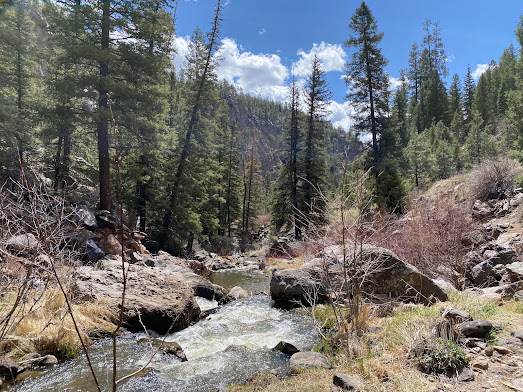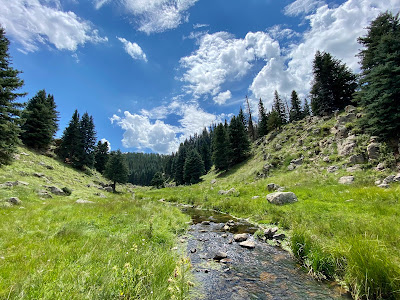Fly Fishing a Rio
One of the things I like about fishing tiny Rios is the gear. Specifically, you can keep it simple and don't really need much gear to have a good day of fishing. If I could only have one rod for these streams, it would be a 7'6" 3wt fly rod. Anything between 6' and 7'6" is a good fit for my high mountain Rios. And, a 2wt or 4wt line works too, with 3wt being the most commonly used in these environments. Most importantly, keep your leader between 6'6" to 7'6" for better control in these tight trout environments. With not much fly line out of the tip, it's easier to control the fly with a short leader....anything from 7x to 5x tippets work for me. The clearer the water and spookier the trout, the finer the tippet I use when rigging up for the day.
Approaching the stream - there are a few things I have in mind as I'm walking up to a stream, especially on my first approach. Most importantly, don't spook the trout! They can be spooked by the sight of you or by the vibrations of you walking over them. Yeah, there are deep cuts under the stream banks where they hide and they can feel your steps as you're walking over them. Instead of walking along the bank edge, move away from the stream to hike up or down stream, and then move in to approach the stream for your cast...walk softly and out of view of the trout. There are some streams where wading spooks the trout and limits your chance of netting one. Only wade when necessary...many of these little Rios are narrow enough to cast a fly to targets while standing on the bank. Note: check park regulations before fishing because there are streams where wading is prohibited.
Feeding lanes - when I'm looking up stream from me, I'm looking for likely feeding lanes. Many days, the trout in these mountain Rios are not visible, so your challenge is to assess where they're treading water below the surface...this is usually on the faster flowing free stone streams. I will float a dry fly in a likely feeding lane closest to me and work intermittent lanes across the stream...this avoids your fly line from landing on top of a trout (and spooking it). Be sure to drift a fly in all the lanes and 'trouty' looking places before moving up to another stream section.
Stand still for a few minutes - this sounds silly I know. However, I have found when I get to the stream's side, if I will stop and just stand still for a few minutes (use time to assess feeding lanes and look for movement), I often find a trout will more likely take my dry fly once I begin casting it into the stream's feeding lanes or typical holding spots (pockets of calmer water). There have been times that I've stood still for up to ten minutes, and then begin seeing ripples or subtle waves of trout movement.
Shadows - it's all about shadows when the sky is cloudless and bright. The trout will be holding in the shadows of the trees or big boulders. I spend my time drifting my flies through the shadows on bright, cloudless days. And, I work to keep my own shadow from crossing likely water where a trout may be holding. When possible, I'll fish from the side of the stream where my shadow is not on the water.
Flies - I'm a dry fly only fisher and use mostly attractor type dry flies. I prefer to focus on getting the right size and color of dry fly to fish my Rios, with color being the most important fly selection factor. Our Leetle Fellers aren't that picky, but getting the color right does make a difference in how many are hitting the surface for a bite of perceived food. Don't ask me about nymphs and midges...I let the trout have the bottom of the stream for safe haven. If they rise to my dry fly, well, that's fair game.
Fly presentation - the softer your fly hits the water, and the less disturbance your fly line makes in the water, the better. Again, the lighter the fly line, the easier it is to avoid splashing water and spooking the trout. This is why I fish with a 2wt rod and line most of the time on my tiny mountain Rios. Yep, managing a tight line with a Leetle Feller on a 2wt rod is an absolute blast!
Your casts are critical in mountain Rios with wild trout and working upstream improves your chance of hook sets...more likely to not be seen by them. Think about your casting angle to avoid your line landing over trout. Work from close in, drifting it through all feeding lanes, before casting further out to another section, again, hitting all feeding lanes. This is my drill as I work my way up the stream and up the mountain.








Comments
Post a Comment